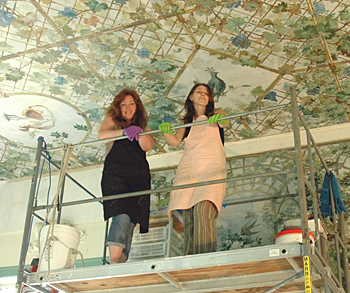
The mural is located in the south loggia of the museum and encompasses the entire ceiling and the upper third of each of the four walls. The design motif is an interpretation of the loggia frescos of the Villa Guilia in Rome, Italy. James Wall Finn was commissioned by interior designer Jules Allard (1832-1907) to paint the loggia murals of Vernon Court. Finn graduated from the École des Beaux-Arts in Paris in 1892 and was a student of the French academic painter and sculptor Jean-Léon Gérôme (1824-1904). He was a prolific muralist, and his work can also be found in the Payne Whitney house in New York and the New York Public library.
The mural has suffered from years of neglect, a leaky roof, and invasive attempts at restoration. UD Associate Professor [of Art Conservation] Richard Wolbers and I carried out an initial condition assessment of the project; the NMAI committed to resources for summer work projects, and I carried out a technical study on the mural over the last year. The objectives of the technical study were to research the techniques used to create the mural and to identify the types of materials present, both original and those used in restoration, so that an appropriate conservation treatment could be designed and administered. The identification of materials used by the artist provided information regarding his method of paint application and creative process, and the materials analysis gathered from the study serve as a guideline for the consolidation, cleaning and loss compensation methods selected for the conservation treatments during the WUDPAC summer work projects this summer and next.
WUDPAC has sponsored Nadège Jacobé, a graduate student from the University of Paris, Sorbonne art conservation program, to work on the project with me, providing a cultural exchange of information and techniques that has enriched our experience and cultivated our friendship. The treatment focus this summer is to stabilize the paint and mend tears in the canvas. It is a challenging project in its size and complexity of treatment issues, but we are enthusiastic about the skills and knowledge we are acquiring. We work in view of the museum visitors, who are encouraged to learn more about the project through tours, didactics and publication materials we have developed with the NMAI staff.

